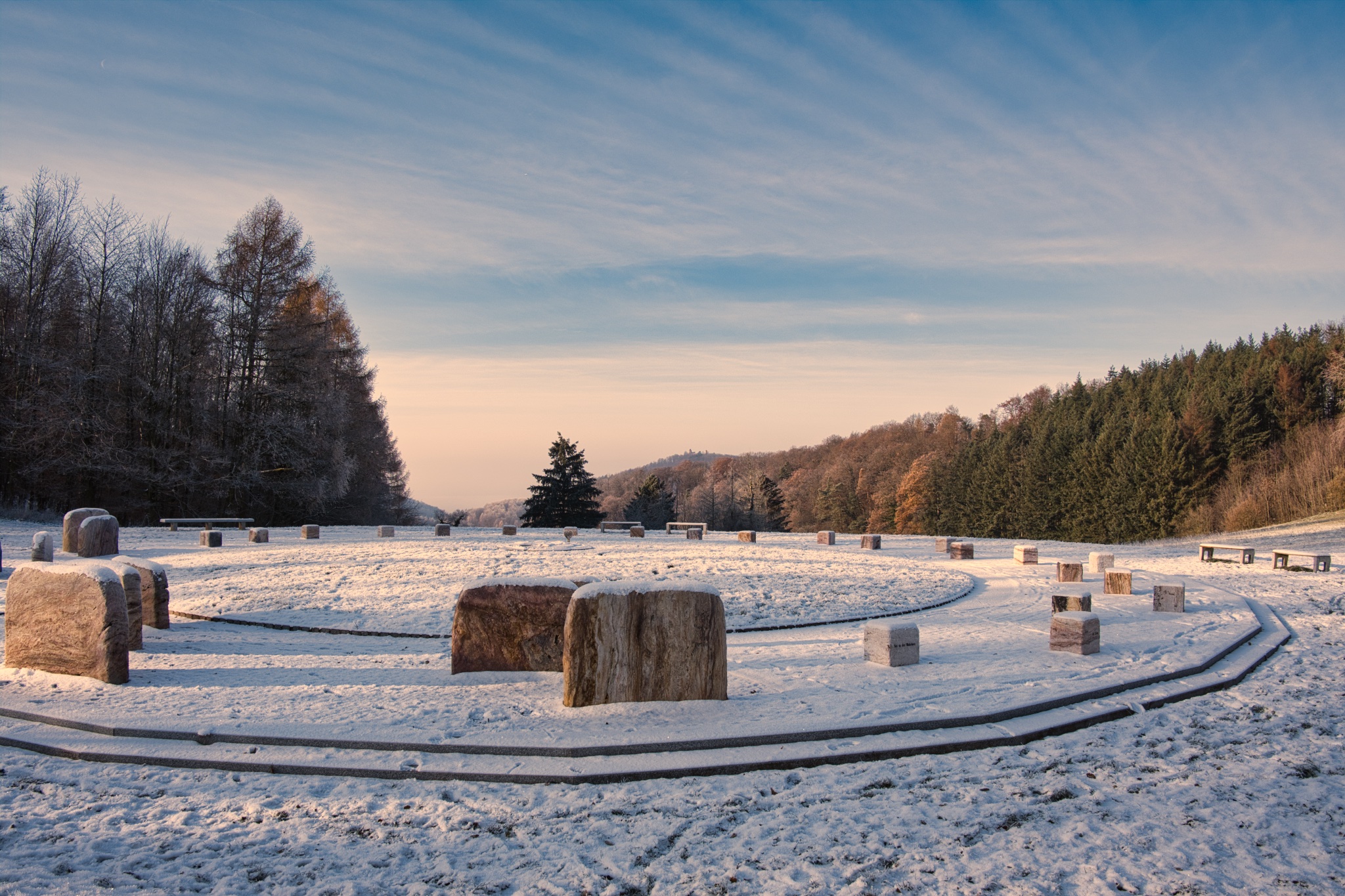The
Tree of Life lying within the Friedensmal, a symbol found in many religions, points its roots towards Jerusalem – a nod to the Christian-Jewish tradition in Germany. It breaks through the 'dark ring of violence' with eleven memorial stones serving as projection surfaces for an alienated and traumatized mind. The ring is also broken from the outside over a bright area, a 'dance floor', a space of encounter with 22 small stone blocks inscribed with values for coexistence. This represents the dance of life and the spiritual and emotional growth that occurs in encounters. The Friedensmal stands for the journey into one's own inner self; where peace begins, where it is therefore most needed. In its center lies the 'Blossom of Life' with its innermost point - which stands for the relationship with God - as a Turning Point. With this message, the Friedensmal becomes a turning point for our society.A memorial for the inner journey to life
Vision and significance of the Friedensmal
The
Friedensmal is not just a stone monument in the landscape; it is a living project and a symbol for humanity's journey towards peace and understanding. In a time when memorials often serve to remind us of the horrors of the past, the Friedensmal offers a different approach. It emerged from the need to expand the culture of remembrance in such a way that life takes center stage, developing into a place of reflection and encounter for people of all cultures and faiths. The Friedensmal invites us to look not only backward, but also inward and forward. It fosters dialogue and inspires people to commit to a more peaceful world. The idea of the Friedensmal is thus an invitation: to see oneself and the world anew, to learn from history, and to actively participate in shaping a better future. In the following chapters, we will explore the various aspects and the deeper meaning of this extraordinary undertaking.In Germany, monuments that address the past are mostly admonishing memorials that confront terrible events. The artist conceived the name Friedensmal at the beginning of this project in 1998. The Friedensmal does not stand against an admonishing memorial, but integrates what is addressed in the memorial. This makes it possible to learn from the past. This Friedensmal was intended to become a Turning Point, leading people back towards the light after periods of darkness.
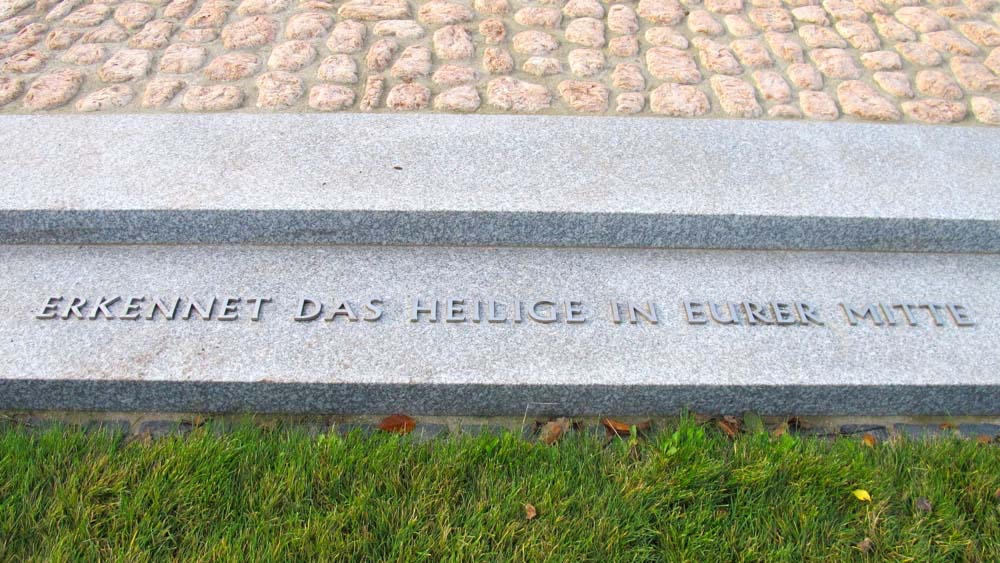
Path of Holistic Healing through Sanctification
The Threshold of Humility
The inscription at the entrance to the
Tree of Life reads: "Recognize the Sacred in your Midst." It is applied to the gray Threshold of Humility that defines the outer limit of the Friedensmal. To reach the center, the visitor crosses this threshold 'on the inward path.' Humans bear the untouchable and sacred within themselves. Hence, it is declared: The dignity of the human being is inviolable (Article 1 of the German Basic Law). May we, in self-awareness, walk the inner path of healing and thereby attain peace and freedom, instead of projecting our own inner pains onto other people and events.In the German word for healing, 'Heilung', lies the (misused) word 'Heil,' related to the Jewish Shalom. Similar concepts are found in various cultures and religions, like 'Shanti' in Hinduism and Buddhism, 'Salam' in Islam, and 'Pax' in Christianity, all representing aspects of peace, harmony, and well-being. The transience in the world (entropy) means the eternal effort of restoration, of healing and Shalom, without which there can be no further development. Not relenting in this is also what 'Recognize the Sacred in your Midst' means. Perfection will never be achieved. It is ultimately about the journey. Knowing this can be liberating: Be human! One's own inadequacies may be acknowledged. Believing otherwise would be delusion. This delusion is well known in Germany: when children were never told that they are valuable, not for their achievements, but simply for being human beings. This applies to an entire society as well.
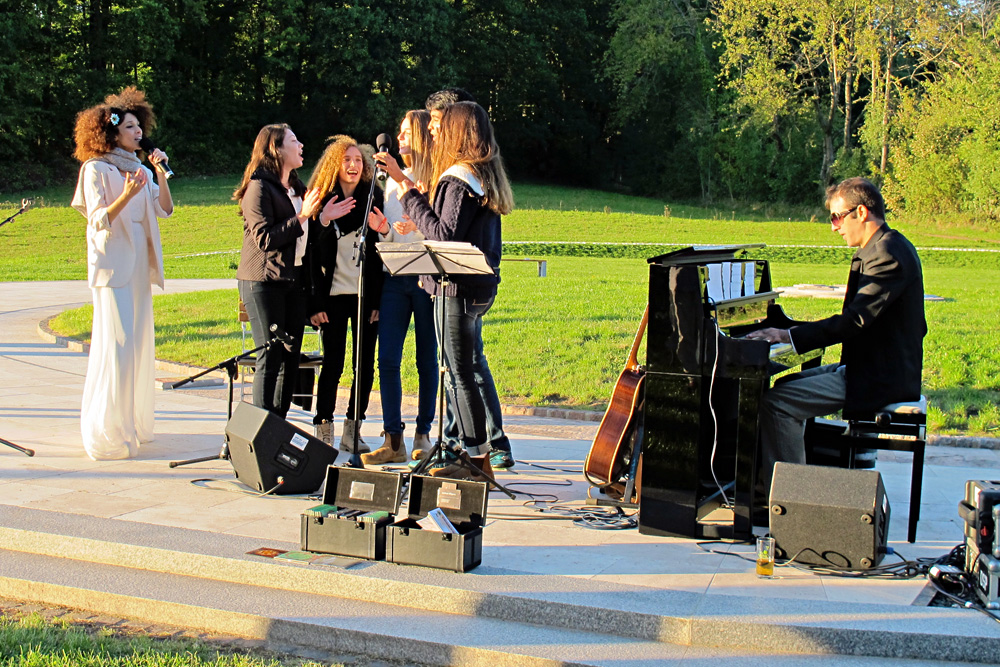
The Israeli singer Dganit Daddo and students from Israel sing at the Encounter Festival in Germany in the Friedensmal.
Delusion in a society does not heal with the same answers that led to the delusion in the first place. It's about breaking the vicious circle; especially in a vibrant culture of remembrance. The phrase '
Recognize the Sacred in your Midst' is not an encouragement to narcissism; it is written on the Threshold of Humility at the Friedensmal. "The truly human is inadequacy, and perhaps the most human thing is to acknowledge, accept, and forgive it, and yet to try to master it, at least one's own." (Source unknown) - So, it's about encouragement on the path of healing through sanctification and a conscious appreciation of the beautiful, true, and good in one's own life and culture, because one might recognize it in the foreign.Tree of Life
The
In the Friedensmal, the Tree of Life is seen in the form of a relief. It symbolizes the relationship with one's own soul. Just as a healthy tree connects heaven and earth, so it happens to a person in their soul, that they may have life in their spiritual connection to a higher consciousness.
The view from above means to consider oneself in the inner experience. The symbolism encourages looking at one's own life and allowing space for good developments in oneself and others. The fight against the bad in the world may never end. But wouldn’t much darkness pass away if one perceives beauty and goodness in oneself and others?
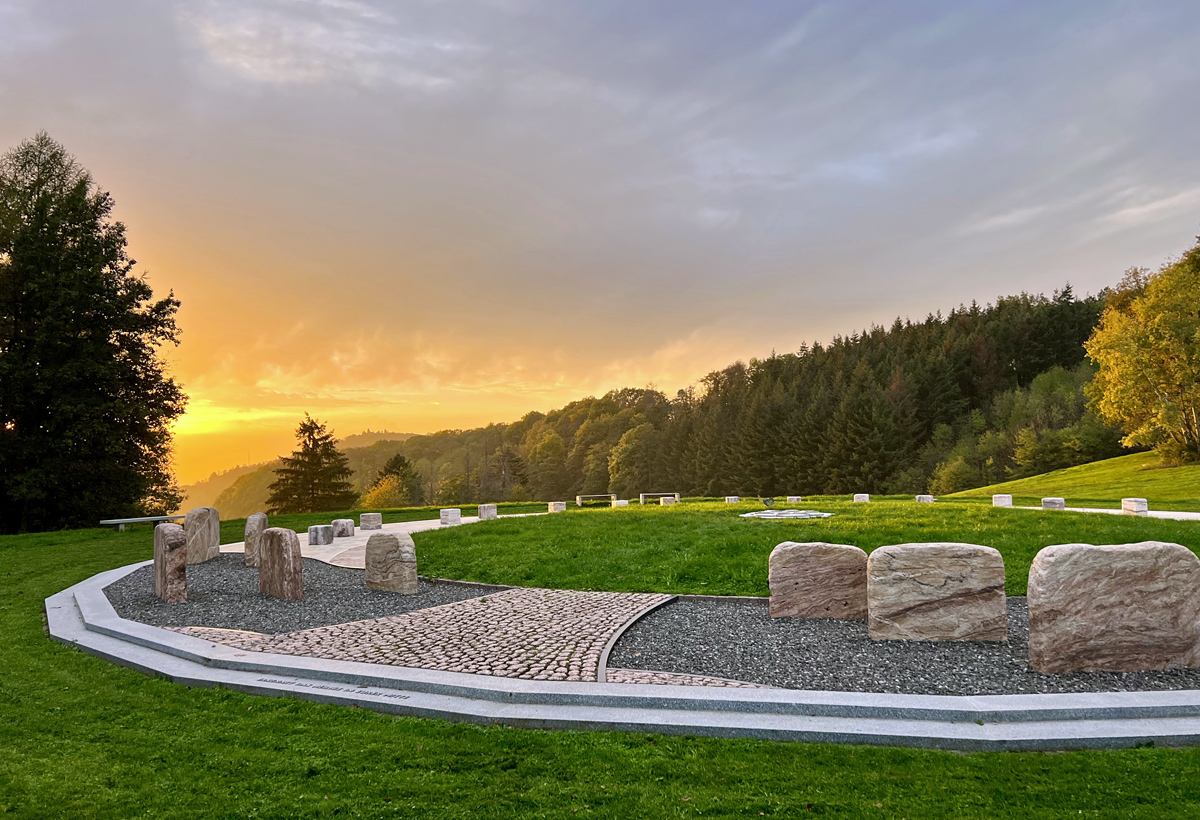
Inner and Outer Dimension
The
Friedensmal is a 24-sided structure. You could walk around it for 24 hours and many days, yet you would only be circling around yourself. Only when you pause and step into the circle of the Friedensmal over two steps - the threshold of humility - with the inscription 'Recognize the Sacred in your Midst' - when you let go of yourself - will you find yourself.The Dark Ring of the Alienated Mind
The Dark Ring surrounding the Tree of Life is filled with dark gravel and symbolizes the alienated mind. In this ring stand 11 memorial stones of Odenwald quartz, serving as projection surfaces for this alienated mind. They are meant to make us aware of how much people are misled by the mind and its ideologies. The limited mind categorizes and projects, which all too often is mistaken for universal truth. This area is also the realm of mental seduction, where propaganda takes effect, and the captivity in ideologies is anchored. Do we seek our support here? Are we prisoners of our projections, perceptions, and fears, or do we see the abundance of life? Thus, we roam through the dark ring and explore our 'stones' in the soul, where they block our love. The Tree of Life breaks through the Dark Ring from within.A Space of Encounter / Dance Floor
The Tree breaks through the Dark Ring from within. The Dark Ring is also broken through by a space of encounter, the beige 'dance floor' in the Friedensmal circle. It symbolizes the true relationship with the Other, which may be like a dance. In this image, I was inspired by the philosophy of the Jewish religious philosopher Martin Buber, who lived until 1938 in my neighboring city of Heppenheim. One of his most famous statements is: 'Man becomes an I through a Thou' (Philosophy of Martin Buber). In the encounter, the other person becomes a mirror to us. This is how we recognize our blind spots. The 'dance floor' is located in the 'inner space', as one creates within oneself the space for encountering the Other, and because one cannot truly see the Other if one does not see oneself. On May 22, 2022, 22 rose quartz cubes were placed in this 'dance floor', inscribed with 22 values for coexistence that serve community building.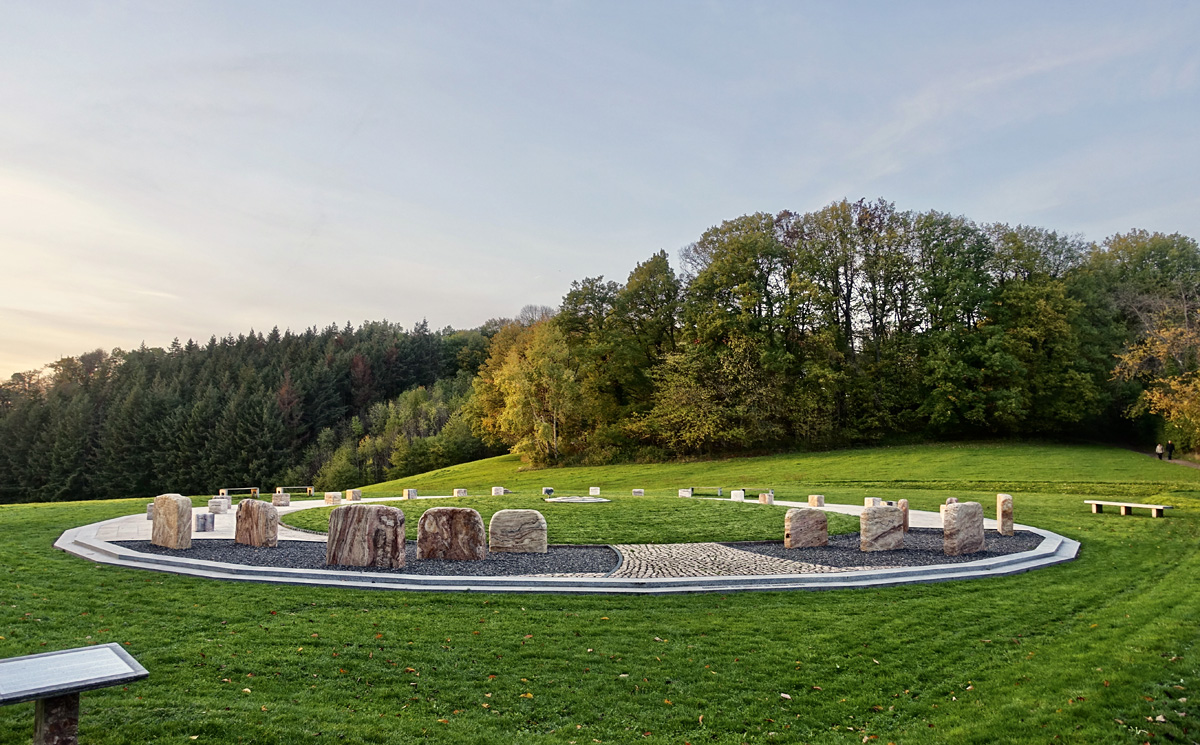
Inner Turning and the Sign of the Covenant
The healing answer is thus the quiet turning inward – it should be a place for meditation and prayer - which equally conveys a feeling and joy for encounter and the dance in life. A 26 m long 7-colored rainbow, to be laid as a glass mosaic on white marble around the 'crown of the tree', symbolizes 'God's covenant with mankind'. The diameter of the
Tree of Life's crown, around which the rainbow lies, is 16.60 m. This references the only biblical passage in the Christian faith with this number, namely Ezekiel 16:60: 'Yet I will remember the covenant I made with you in the days of your youth, and I will establish an everlasting covenant with you.'Numerology in the Friedensmal
The Mystical Meaning of the Number 11
In the Friedensmal, within the 'Dark Ring of the alienated mind,' stand 11 memorial stones. In Christian mysticism, the number 11 has a special significance. It is seen as the number of sin, or as Tillisch in the Lexicon of Theology on sin elaborates, a symbol for the alienation of man from the 'ground of being' (God), from other beings, and from themselves. In this symbolism, the 1 stands for the will of God and the 0 for the receptive principle, the creation. Thus, the number 10 represents the will of God in creation and the Ten Commandments. The 11 adds human will, which has fallen out of this divine order. It becomes a number of liberation when the responsibility within it is understood.A Reference to the 12th Stone Outside
When leaving the Friedensmal, where metaphorically inner peace can be found, one encounters the 12th stone, the Stone of Encounter, with the inscription 'Yerushalayim'. This number symbolizes the restored harmony with the 'ground of being,' that is, with God. It represents service to God, similar to what is described in the Jewish Torah: The Israelites found their freedom by leaving Egypt to serve God.This Stone of Encounter and its inscription are an important part of the Friedensmal's symbolism, as they represent the transition from the inner search for peace to the external realization of freedom and harmony. The inscription Yerushalayim establishes a connection with the Jewish-Christian heritage of our culture, with its light and traumas to be healed.

Entrance into the Tree of Life
At the opening of the monument in Hochstädten in May 2012, people from the locality removed their shoes as they entered the Tree of Life. This act is found in various forms in Judaism, Hinduism, Buddhism, Islam, and in other cultural and religious contexts worldwide and symbolizes the universal significance of purification and spiritual preparation when entering a sacred space. The act of 'removing the shoes' is understood in many cultures and spiritual traditions as a sign of humility and sanctity. It invites leaving behind habits and prejudices and entering a sacred experience with an open heart. In such a space, one can find Peace, Shalom, Shanti... The Friedensmal can reawaken the inner longing for sanctity in people. We need signs of hope that touch the goodness in us. The greatest misfortune in a society does not happen through 'evil people', but because the good potential in it is not recognized! Responsibility for life is positive. It wants to express itself in the engagement of freedom-loving and responsible citizens. In this spirit, this project was implemented over many years of volunteer work on private property.Jerusalem and Healthy Boundaries
With its roots pointing towards Jerusalem, this Tree of Life calls for a 'better world'. This call is more than a place; 'Jerusalem' describes a state of beauty in the Jewish-Christian context. Thus, peace begins within, from where it impacts the small and from there into the larger contexts in the world. - Yerushalayim, the name of Jerusalem, is inscribed on the 12th memorial stone of the monument, the Stone of Encounter. The stone stands outside the Friedensmal at the boundary to the European long-distance path, facing 'the world'. The theme here is also: healthy boundaries.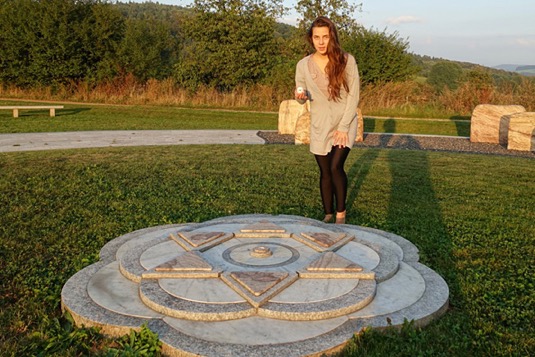
In the center of the Friedensmal lies the Blossom of Life
The Friedensmal, with the Blossom of Life at its center, represents a space for healing and encounter. It invites us to journey into our inner selves, a place where we have the power to effect change. This inner journey can help us find peace within ourselves and then carry it outward into our society. The Blossom of Life in the Friedensmal thus becomes a universal symbol, reminding us of our shared responsibility and ability to contribute to harmony and peace in the world.
This blossom made of white marble, granite, and Odenwald quartz is also a reminder of a resistance group that named itself after a white flower: The White Rose
Jerusalem as a Cultural Root
The individual is also part of a cultural community with its imprint and history. Therefore, this monument - with the orientation of the root of the 'Tree of Life' towards Jerusalem and the inscription 'Yerushalayim' on the 'Stone of Encounter' - references 'Jerusalem' as the deepest root of European culture and the deep wound in this relationship. This is an important societal impulse for our country to rediscover itself through an understanding of 'Jerusalem', even becoming an
Idea of Jerusalem in German-Jewish relations.Sacred Geometry
The Symbolism of the Blossom
The
Blossom of Life carries the seed of life. It consists of twelve white petals and a star resting on them: a heart that lives!This star also symbolizes the connection between 'Heaven' and 'Earth'; between spirit and matter. The flower is located in the center of the Tree of Life in the Friedensmal: just like a tree, a human can connect heaven and earth within themselves; in Christian terms, this is the person filled with the Holy Spirit.
There are two triangles in the star; one triangle with the brown spot at its tip points towards the Rhine plain with the former 'Jerusalem on the Rhine' ('Heaven'; i.e., idea, cultural realization) and the other triangle with the brown spot at its base points towards Jerusalem in Israel ('Earth'; i.e., cultural roots).
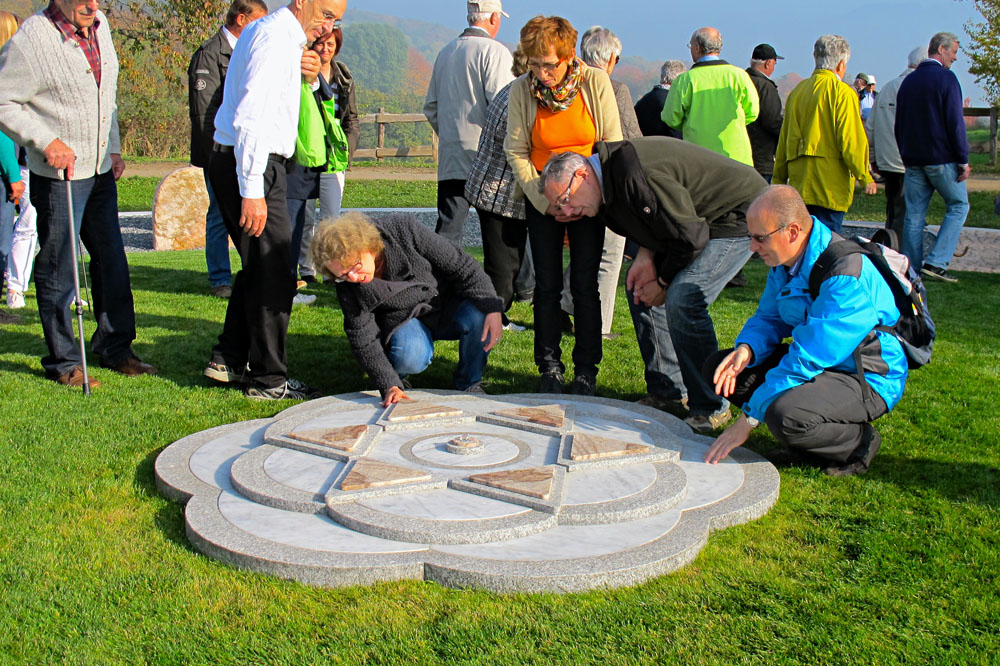
The Blossom of Life right after completion. In the center, there is not yet a marble slab, but still a glass stone.
A Point That Connects Everything
In the center of the 'Blossom of Life,' an Orthodox Jewish rabbi placed a marble slab with the Hebrew inscription 'Chai,' meaning: live. This
This point in the center is exactly 72 cm above the level (outside) in front of the first step of the Threshold of Humility. This is a reference to the 72 names of God in the Judeo-Christian tradition; it's about experiencing the spirit in its many facets.
